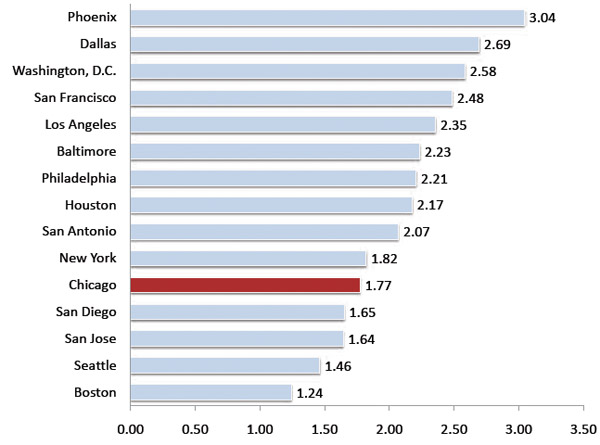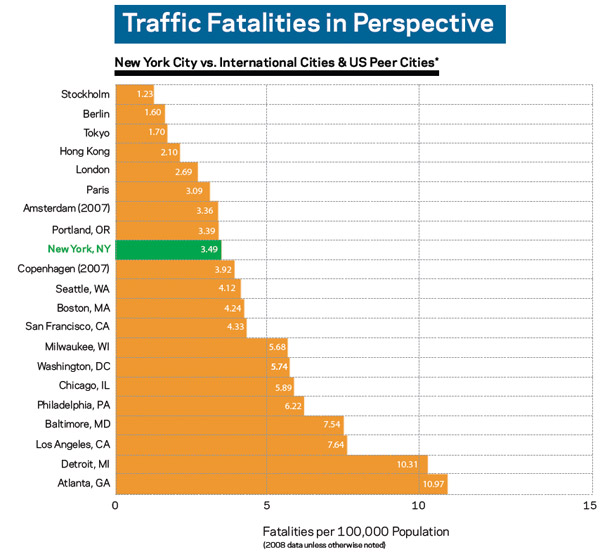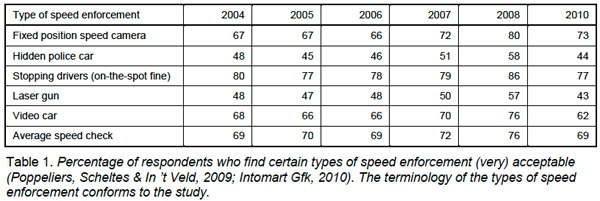The back-and-forth between the local media and Rahm Emanuel on the speed camera fait accompli has generated some good reading, including the full transcript of an interview between Emanuel and David Kidwell about how decisions are made in the mayor's office and how that information is disclosed. Over at Gapers Block, Ramsin Canon has a thoughtful piece about the interview and the tensions between FOIA and honest counsel: "Mayor Emanuel's abrasive defense, in other words, shouldn't be taken as mere pretext for opacity."
The interview was part of a story by Kidwell, Kristen Mack, and Bob Secter about the push for speed cameras and the public records involved:
The records, many of them heavily censored, offer clues into City Hall's misstatements about a pedestrian safety crisis, the role of a well-connected speed camera lobbyist and how the mayor linked the death of a little girl to his campaign for cameras even though the devices wouldn't have saved her.
This hearkens back to a November piece in the Trib, "Emanuel Speed Camera Push Runs Into Statistics."
Chicago logged 251 pedestrian fatalities between 2005 and 2009, but fewer than half occurred in the "safety zones" where cameras would be allowed to operate under Emanuel's plan, and fewer than half of those involved speeding.
The same statistics show that two-thirds of speed-related deaths involving pedestrians age 18 or under also happened outside Emanuel's proposed enforcement zone — 8 of 12 in all.
[snip]
Testifying before the Senate Transportation Committee, Chicago police Superintendent Garry McCarthy punctuated his call for quick action on speed cameras with a chilling statistic: the rate of pedestrian fatalities in Chicago was 68 percent higher than in New York.
That assertion, however, contradicts the city's own recently released analysis of pedestrian crashes that found the pedestrian fatality rate here lower than in New York and many other large municipalities. It concluded that "relatively speaking, Chicago has a safe pedestrian environment given the volume of traffic."
A city spokesman said McCarthy appeared to have garbled the findings of a different study that said the rate of fatalities in all traffic accidents, not just those involving pedestrians, was higher here than in New York.
About the conflict between what McCarthy said and what the city's analysis reported: The city found that Chicago has a lower pedestrian-fatality rate than New York, and "the lowest pedestrian fatality rate of cities over 500,000 residents with a population density greater than 5,000 residents per square mile," for the years 2005 through 2009 (PDF, 2011).

So Chicago is a very slightly safer pedestrian city than New York, over that time frame, and good compared to cities in our weight class. But, at least for 2008, Chicago had a higher overall traffic fatality rate than New York—60 percent higher. I haven't found the study that McCarthy is said to have garbled, but this suggests his figure is plausibe; it seems pretty well established that New York has a lower overall traffic fatality rate than Chicago (PDF, August 2010).

So McCarthy got his reference wrong, but if you replace pedestrian fatalities with overall fatalities, he's got a point.
That's been the odd thing about the speed-camera debate. The city has been emphasizing pedestrian safety, and they've stumbled with the argument:
"While we're speaking, Diamond Robinson, who was hit by a car near a school … they're actually having her funeral," Emanuel said. "That is a reminder of what we're talking about today and the full price and consequences of what we're talking about today."
Emanuel's legislation, if it had been in effect, would not have protected Diamond. The accident occurred on a weekend, and the new law restricts use of cameras near schools to weekdays.
And that's led us to argue at cross-purposes. McCarthy flubbed a stat, and it got shot down. Emanuel argued from anecdata, and it got shot down. It reminds me a bit of when the administration relied on an intuitive-seeming but faulty analysis about the damage SUVs do to city streets, but with one very important caveat: there is substantial evidence in favor of speed cameras. And in this spat about a couple mishandled data/anecdata points, it's been lost.
Over at Grid Chicago, Steven Vance has a nice roundup of the research on speed cameras, and comes away impressed by their effectiveness.
There have been reductions in the number of people speeding, and the number of injuries and fatalities, in locations where speed cameras are installed and operated. In my assessment of multiple studies, it seems that speed cameras are a main cause of these reductions. The effect varies in each region studied, though.
Vance also points out something important about the Trib's focus on pedestrian deaths: "I think their study discounts the focus on reducing injuries as well as fatalities." In fairness to the Trib, it's a focus the city invited by invoking Diamond Robinson and pedestrian traffic fatalities. And I'm as opposed to young pedestrians being killed in traffic accidents as the next person, but it's far from the only reason to improve traffic safety. And Vance turned up a bunch of studies that found noticable impacts:
The sites were compared to equivalent sites in nearby Baltimore, Maryland, which did not have speed cameras anywhere. One of the results of the study: “The proportion of vehicles at Washington sites exceeding the speed limit by more than 10 MPH declined by a statistically significant 82 precent compared with the Baltimore sites”.
[snip]
The reduction in speed has been greatest in urban areas. (2) Casualties are down. Where cameras were introduced, there has been a statistically significant reduction in casualties. The greatest reduction has been in killed and serious casualties. ”
I found some of my own, including a 2008 study of Montgomery County, Maryland (PDF):
In 2007, Montgomery County implemented the state of Maryland’s first automated speed enforcement program, with camera use limited to residential streets with speeds limits of 35 mph or less and school zones. Vehicle speeds were measured approximately 6 months before and 6 months after speed cameras were deployed, and signs were installed warning of the speed enforcement program. Relative to comparison sites in Virginia, the proportion of drivers traveling more than 10 mph above posted speed limits declined by about 70 percent at Montgomery County locations with both warning signs and speed camera enforcement, 39 percent at locations with warning signs but no speed cameras, and 16 percent on residential streets with neither warning signs nor speed cameras.
And how'd that play politically? Almost as well as the speed cameras reduced speeding:
Six months after enforcement began, 60 percent of drivers were aware of the camera program and 62 percent supported it.
Scottsdale, Arizona tried speed cameras on the freeway to similar results:
In 2006 the city of Scottsdale, Arizona, implemented a 9-month pilot program to evaluate the feasibility and effects of highly visible speed camera enforcement on a busy urban freeway. This was the first use of fixed speed cameras on a major US highway. Deployment of six cameras along an 8-mile corridor was associated with large declines in mean speeds and an 88% decrease in the odds of vehicles traveling 11mph or more above the 65mph limit. Traffic speeds increased soon after the pilot program was suspended. In addition to reducing speeding along the enforcement corridor, speed cameras were associated with large reductions in speeding on the same highway but 25 miles away from the camera installations…. Public opinion surveys found widespread concerns about speeding on the Loop 101 freeway and high levels of support for speed camera enforcement on this road.
A recent review of the literature out of the Institute for Road Safety Research in the Netherlands (PDF) was also quite positive on the effects of speed cameras, though they do caution about the understudied possibilities of "kangaroos": people who decelerate suddenly when they see a speed camera, then speed up after it. I'm sure you've seen the same effect with cop cars on the interstate. They also included the results of a six-year survey of Dutch citizens and their attitudes towards different types of speed enforcement, and the results were really interesting:

Basically, hidden and more secretive forms of busting drivers are less popular than fixed-position speed cameras. I think this makes sense; one abstract advantage of speed cameras is that they're not arbitrary. If you speed and get caught by a hidden cop car, well, you were speeding, but then again so were a bunch of other people all over creation. If you speed and get caught by a speed camera, you can't blame fate. They also spare you the misery of getting pulled over and having the inevitably tortured no, officer, I didn't realize… of course I won't do it again conversation, which I doubt cops particularly enjoy either.
The whole dialog over speed cameras has been a bit frustrating. They're not a magic bullet; they're not going to save all the children from getting hit by cars. It's the rare innovation that virtually eliminates an entire public safety issue. But the existing evidence strongly suggests that they would improve conditions on the streets they're installed on, and somewhat beyond that in an observed "halo effect." And those modestly substantial gains are what a lot of public policy is about.
Update: Even more:
As the ITE Journal notes, since 2000, France has reduced its road fatality rate by an incredible 43 percent. Instrumental in that reduction has been a roll-out of automated speed cameras and a toughening of penalties. For example, negligent driving resulting in a death, which often results in little punishment in the United States, carries a penalty of five years in prison and a 75,000-euro fine.


